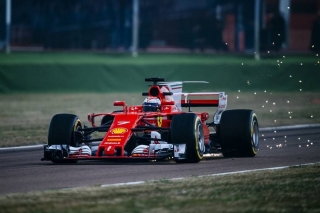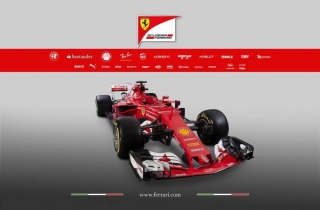SF70H: Straight to the track
Posted: 24.02.2017 / Source: Ferrari
“Our Ferrari” completes 100 Km during a filming day at Fiorano
Maranello, 24 February –The number refers to the seventy years of history, which is truly unique for any marque in the sport. The letters in the name stand simply for Scuderia Ferrari and the Hybrid form of power. The Italian flag is clearly visible on the “sail” of the engine cover, with a look that recalls the 70s. After the launch, the Ferrari SF70H, built to compete in the Formula 1 World Championship, also took its first steps today at the historic Fiorano track, combining the shakedown with a filming day to acquire footage for commercial purposes. The car is made up of 56 thousand components, produced thanks to the work and collective effort of the thousand or so men and women from the Gestione Sportiva, over a gestation period of twelve months. The car is visibly different to its recent predecessors, as a result of regulation changes for 2017 aimed above all at increasing performance.
The shutters to the Fiorano pit garage, which had been decked out in a unique look just for today, came up at 9h45 Italian time, watched by the President and CEO of the Prancing Horse Sergio Marchionne, Team Principal Maurizio Arrivabene, Technical Director Mattia Binotto, the drivers Kimi Raikkonen, Sebastian Vettel and Antonio Giovinazzi and all the staff, who were watching the presentation from nearby in the Maranello headquarters. After the routine preparations, the car drove out of the garage at 11h20, fitted with the “Demo” tyres which have to be used on filming days. They were to the same larger sizes as this year’s tyres, but the compounds were different. It was certainly a rare sight, seeing a current year model Formula 1 car running on Ferrari’s home track: the rules no longer allow in-season testing, apart from the collective ones for all teams. The sole exception is in fact the 100 Kms allowed for a promotional day, which first Raikkonen and then Vettel made the most of , splitting the allowed distance equally between them, despite the rain which delayed Sebastian’s first run until 15h40.
Once the day’s work was over, all the employees got the chance to see the SF70H up close, before the car was loaded up onto a transporter, ready to head for the Catalunya Circuit, where the first of two pre-season test sessions gets underway on Monday 27th February. Each session runs for four days. Vettel is due to drive on Monday and Wednesday, with Raikkonen taking over for Tuesday and Thursday. The second test gets underway on Tuesday 7th March.
Ferrari SF70H
Posted: 24.02.2017 / Source: Ferrari
The 63rd single-seater designed and built by Scuderia Ferrari to take part in the Formula 1 World Championship is born out of a regulation change that is without precedent in this category of motor sport. Generally, in the past, regulations went in the direction of slowing down the cars. However, this year, the rule changes go in the opposite direction, meaning the cars have more aerodynamic downforce and more mechanical grip.
AERODYNAMIC CONCEPT. On this topic, the Gestione Sportiva group has concentrated its efforts on finding the right compromise between downforce and aerodynamic resistance, or drag. The new Pirelli tyres are much wider than in the past, by 6 centimetres each at the front and 8 at the rear. This increased frontal area constitutes a “brake” on forward motion as does the increased downforce coming from the 2017 specification front wing, floor and diffuser. Countering this effect, the combination of downforce and the bigger footprint from the tyres translates into increased grip, leading to higher cornering speeds.
CHASSIS. There are several differences between the SF70H and Ferraris from the recent past: the lengthened nose and the arrow-shaped wing are a consequence of the regulations, as is the obvious fin on the engine cover and the more complex aero appendages ahead of the air intakes on the sidepods, whose unusual shape was designed in harmony with the front crash structure. Visible at the front is a duct that has an aerodynamic role, while behind the driver, the roll-hoop, which incorporates the engine air intake has been completely redesigned. Also updated is the suspension layout, which still retains a push rod design at the front with pull rods at the rear. The hubs and wheel nuts have been redesigned to facilitate the work of the mechanics when changing wheels during the pit stops. Finally, also as a function of the expected increase in performance this year, the power-steering and braking systems have been upsized.
POWER UNIT. In contrast to the aerodynamics, when it comes to the power unit, there have been few changes to the regulations. The main one concerns the amount of fuel that can be used by each car during the race: with the predicted increase in performance, with a bigger percentage of each lap spent at full revs, the permitted amount of fuel has increased from 100 to 105 Kg, although the flow rate is still fixed at 100 kg/hour. The 062 engine is a definite step forward compared to its predecessor, when it comes to chasing performance. The layout of some of the mechanical components on the hybrid power unit has been revised, while other areas maintain a similar layout to the 2016 car. On the sporting regulation front, the abolition of the “Token” system allows the teams more room for development over the course of the season.
Technical Specifications
| Engine | |
| Capacity | 1600 cc |
| Max revs | 15,000 |
| Supercharging | Single Turbo |
| Fuel flow | 100 kg/hr max |
| Fuel capacity | 105 kg |
| Configuration | V6 90° |
| Cylinders | 6 |
| Bore | 80 mm |
| Stroke | 53 mm |
| Valves | 4 per cylinder |
| Injection | 500 bar – direct |
| ERS System | |
| Battery energy (per lap) | 4 MJ |
| MGU-K Power | 120 kW |
| MGU-K Max revs | 50,000 rpm |
| MGU-H Max revs | 125,000 rpm |
| Technical Data | |
| Chassis in carbon-fibre and honeycomb composite structure | |
| Ferrari longitudinal gearbox | |
| Servo controlled hydraulic limited-slip differential | |
| Semiautomatic sequential and electronicallycontrolled gearbox with quick shift | |
| Number of gears: 8 +R | |
| Brembo ventilated carbon-fibre disc brakes(front and rear) and brake by wire rear brakes | |
| Pushrod front suspensionPullrod rear suspension | |
| Weight with water, lubricant and driver 728 kg | |
| OZ wheels (front and rear) 13” | |



















